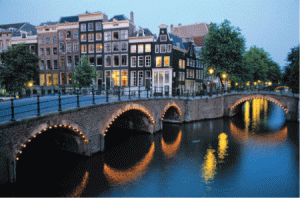Substantial houses, as uncompromising as the Dutch matrons of old oil paintings, watch over the canals. The curvilinear pediments gracing the roof fronts mimic the starched winged bonnets of Rembrandt’s respectable womenfolk, the fancy window shutters — the showy lace cuffs of their best dresses.
In the sex trade district, at the windows of the lower floors, a red light signals ‘open for business’. The painted lady cavorts in the frame of the window, her flesh artfully accented by bustier, thong, garter belt and stockings. She gazes out as though looking into the lens of a camera, poses with a nail buffer or hair comb; she is an animated portrait of the same woman you’d once have seen in sepia-toned Edwardian post cards, quaint, coy, lady-like — pre-Playboy erotica . A gaudy butterfly trapped in a display case.
The sex industry is regulated in Amsterdam. Business and premise are licensed. Both worker and client are protected by health and safety regulations. The rates for service are up-front and surprisingly low.
Not one classic beauty in sight, a few cellulite-free, conventionally pretty younger women, but on the whole a collection of ordinary women — your sister, your daughter’s friend, the girl at the supermarket check-out, your mother — doing a day’s work, primarily evening shift , in five inch heels and false eyelashes.
When the red window curtain is drawn, I presume a fee-for-service act is being performed. I like to think that somewhere on the window there is a notice that reads: Back in five minutes. Please wait. Form an orderly queue.

Dearest Anne!! How are you?? How is your family?? How is Ivan?? It seems like you had a little trip to Amsterdam 🙂 I hope you and your friends had a great time 🙂 It’s sunny and warm(-ish) today and that has lifted my mood greatly. I did something very stupid, thinking that Spring has arrived: I checked the meteo report 😦 It seems today is a one-off and it will be colder later this week. Dumb of me, but I was so hopeful. It’s difficult to live in the moment. The weather has inspired me to clean like I haven’t in a couple months. Today I start my 40 day fast of all things animal. Being that I am a regular vegetarian now, and was a strict vegetarian for many years, this is not a super challenge. My father in law is eating over tonight and I prepared a pistachio cake with chocolate sorbet for dessert. The cake has no eggs or milk and turned out very good 🙂 I hope he thinks the same. One good result of living in France, where going out to eat can cost a couple days’ salary, is that I have become a wonderful cook!! Outside of attempting Ethiopian food, I have had great success 🙂 I am almost finished with one of my three New Year’s Goals. Reading Little Dorritt has been nice but as I’m almost done I should start thinking about what to tackle next. Something light, I think!! Do you have any suggestions?? My other Goals are to lose these last 3 sticky kilos and discover someplace new, but I still have time for those. Madeleine and Alexandre are doing well. In his efforts to start walking, Alexandre has taken quite a few spills, but I love coming to his rescue 🙂 He is such a little love. Please be well and let me know of your adventures. I’m so happy to have heard something of you, Anne 🙂 bisous!!juliemarie Date: Sun, 17 Feb 2013 22:56:22 +0000 To: jmariebouille@hotmail.com
Do you mind if I quote a couple of your posts as long as I provide credit and sources back to
your webpage? My blog is in the exact same area of interest as yours and my users would certainly benefit from some of the information you provide here.
Please let me know if this alright with you. Regards!
Certainly.